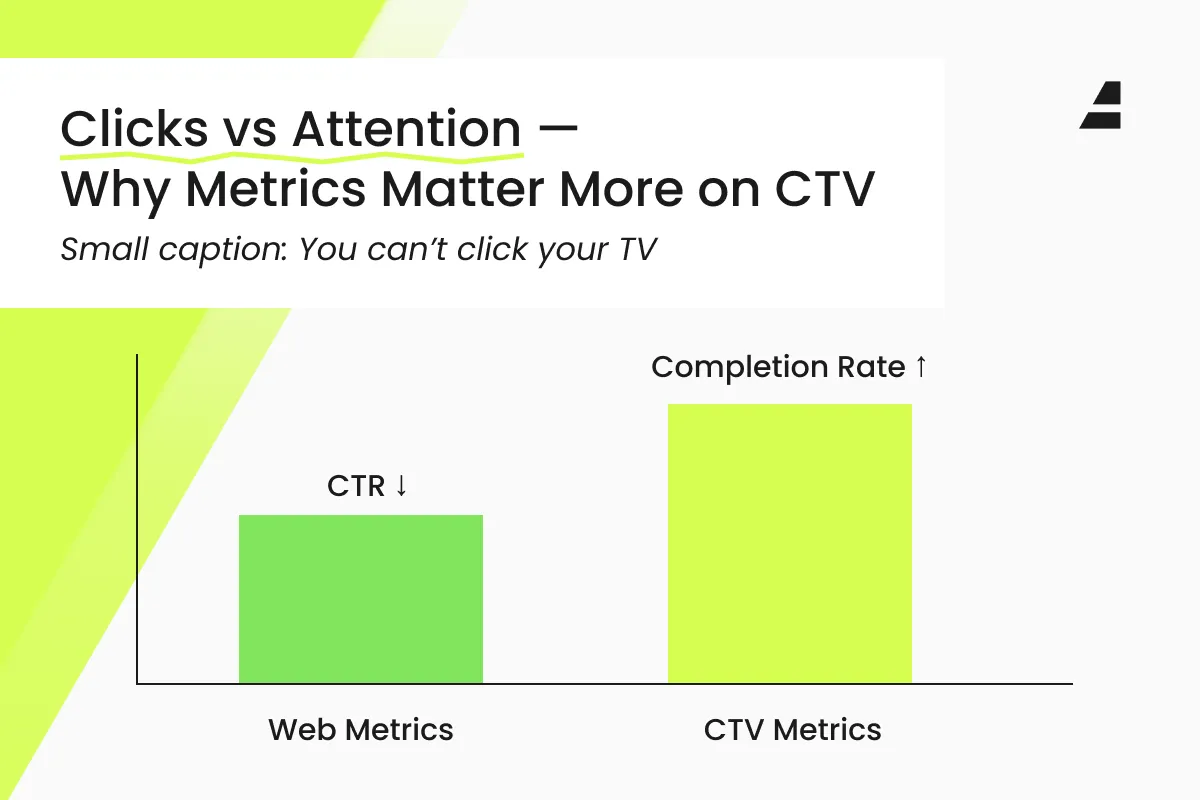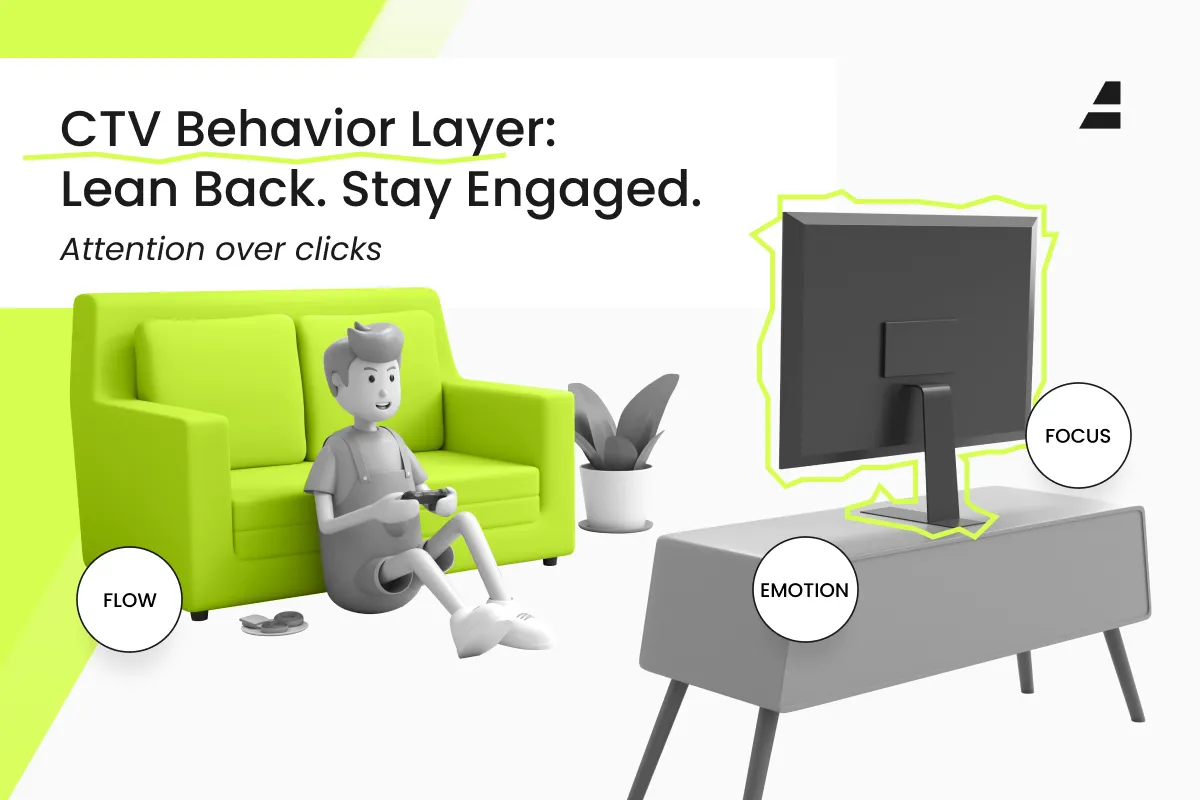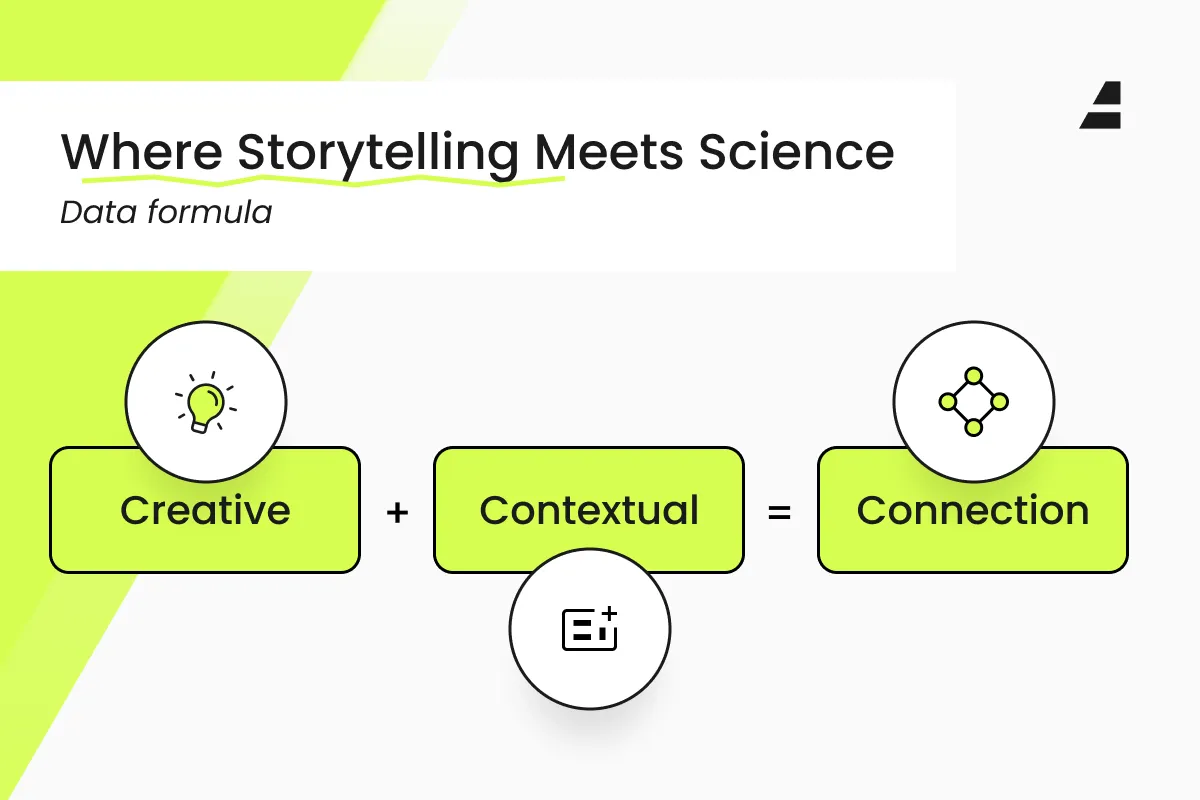Connected TV (CTV) isn’t just another digital channel. It’s a completely different ecosystem — where viewers lean back, not scroll, and where the quality of attention outweighs the quantity of impressions.
Yet many advertisers still treat CTV as a stretched-out version of web video. They copy-paste digital playbooks, track click-throughs, and optimize around outdated attribution models. The result? Wasted inventory, missed opportunities, and campaigns that measure activity instead of impact.
CTV deserves better. And the advertisers who adapt first will define what “better” really means.
The Problem: Click Metrics, Outdated Attribution, and Copy-Paste Tactics
When web-based tactics enter CTV, friction follows. The issue isn’t the ambition — it’s the metrics.
Web advertising was built around direct response logic: clicks, conversions, and last-touch attribution. But none of those concepts translate naturally to the living room screen. No one is tapping a banner ad on their TV remote, and yet some brands still evaluate CTV performance as if they might.
This approach traps marketers in a loop of false negatives. Campaigns that truly drive awareness or offline conversion often appear underperforming simply because they can’t be measured in clicks. And attribution models built for desktop or mobile ecosystems rarely account for shared devices, multi-session journeys, or CTV’s household-level engagement patterns.
The irony is clear: CTV offers richer storytelling, stronger viewability, and deeper emotional impact — but its potential is lost when measured through a web-era lens.

Bar chart comparing web CTR metrics to CTV completion rates, illustrating why traditional click-based KPIs fail on Connected TV.
CTV’s Unique Behavior Layer: Attention Over Clicks
What makes CTV powerful isn’t its technology — it’s its psychology.
Viewers aren’t multitasking in the same way they do online. They’re immersed in a content experience designed for focus and flow. When a brand enters that environment with relevance and respect, it doesn’t just reach an audience — it earns attention.
That attention is measurable, but not in the traditional sense. Metrics like completion rate, ad view time, and contextual alignment paint a far more accurate picture of performance than any click-through ratio ever could.

Illustration of a viewer engaged on a couch with a TV screen, symbolizing focus, flow, and emotion — the behavioral layer unique to CTV engagement.
In CTV, engagement is implicit. When a viewer stays through your ad instead of skipping, when recall remains high days later, when message association lifts purchase intent — those are the real KPIs.
At Afront, we see attention as currency. Our platform helps advertisers translate those signals into meaningful outcomes, ensuring that CTV campaigns are optimized not for mechanical interaction but for emotional connection and brand influence.
How Afront Measures Real Impact on CTV
Afront’s approach to CTV analytics replaces assumptions with intelligence.
Rather than repurposing display logic, we use AI-driven modeling to track how ads influence behavior across devices and time. Through impression-level insights, audience segmentation, and contextual data, we capture not only who saw the ad — but how they engaged, remembered, and responded to it later in their journey.
Our performance engine combines exposure data with advanced outcome signals — view-through, incremental reach, and attribution blending — giving advertisers a true understanding of return on attention.
By aligning creative delivery with audience receptivity and content context, Afront turns passive impressions into active awareness. This means advertisers can finally measure what CTV is built for: visibility, recall, and real business lift — not empty clicks or vanity metrics.
For publishers, this translates into stronger buyer confidence and better yield outcomes. For brands, it means clarity in investment and creative accountability.
New Best Practices: Creative + Contextual = Connection

Infographic showing the formula “Creative + Contextual = Connection,” representing Afront’s approach to effective CTV storytelling.
CTV isn’t just about being seen — it’s about being remembered.
Old digital habits often treat creative and context as separate disciplines. In reality, they are inseparable. The same message can perform dramatically differently depending on its placement, sequence, and emotional tone.
When a fast-food brand appears between episodes of a cooking show, or a travel ad surfaces during a family movie night, context enhances recall by 3–5x. When storytelling adapts dynamically to mood, moment, and screen, connection replaces disruption.
Afront’s CTV platform is built around that principle. We help advertisers design creative that complements the content environment, does not interrupt it — leveraging contextual AI to serve the right message, at the right moment, to the right audience mindset.
This harmony between creative and context is what elevates CTV beyond “just another screen.” It’s not about replacing the web; it’s about redefining what digital storytelling can achieve.
If you’re exploring how privacy, consent, and trust are shaping modern advertising frameworks, read our previous article — Privacy Isn’t Binary: Navigating the Real Trade-Offs.
Conclusion: Building for the Screen That Deserves Better
CTV isn’t a sandbox for recycled tactics — it’s a new frontier that rewards creativity, precision, and respect for the audience experience.
Legacy web logic focused on conversion paths and quick clicks. CTV demands deeper thinking: how to hold attention, how to connect contextually, and how to measure meaning instead of motion.
Advertisers who make that shift now will set the standard for the next generation of digital performance.
Different screen. Different science. Afront makes it perform.
Be seen. Be measured. Be Afront.
